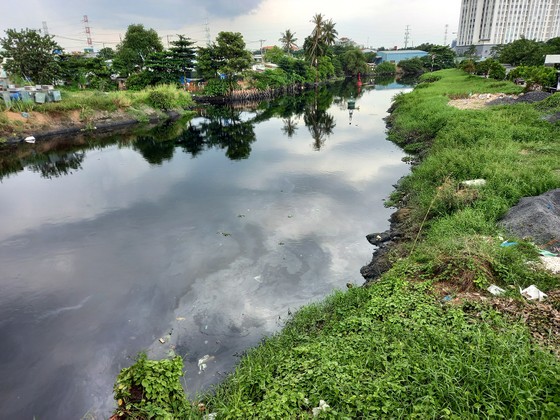 Environment
Environment

 |
| The water in a section of the Tham Lương – Bến Cát – Rạch Nước Lên Canal in HCM City’s District 12 is black and stinky. — Photo www.sggp.org.vn |
HCM CITY — HCM City is calling for investment in six planned wastewater treatment projects to treat about three million cubic metres (cu.m) of wastewater a day in the city.
The planned wastewater treatment projects include Bắc Sài Gòn 1, Bắc Sài Gòn 2, Cầu Dừa, Tây Bắc, Tây Sài Gòn and Suối Nhum.
The city plans to open bidding for selecting investors to implement these projects by 2025, and expects to complete them in the period of 2026-30.
These projects will help the city reach its target of treating 100 per cent of domestic wastewater before being discharged into the environment.
In recent years, the amount of wastewater discharged into the environment has continuously increased. Between 2018 and 2021, the average wastewater volume is estimated to have increased by 6.7 per cent each year.
More than 1.5 million cu.m of wastewater is generated daily in the city, according to the city’s Department of Construction.
Meanwhile, the total amount of treated wastewater in the city only accounts for 12.6 per cent.
Untreated wastewater is discharged directly into the environment, affecting the landscape, water quality and daily life of people.
For example, the Tham Lương – Bến Cát – Rạch Nước Lên canal in the city districts of Bình Tân, Tân Phú, Tân Bình, Gò Vấp, Bình Thạnh, Bình Chánh and 12 has become a nightmare for residents on both sides of the canal because of its foul smell every time it rains.
The canal has been polluted for many years, affecting the living conditions of local residents.
Trần Thị Ngọc, a resident in District 12, said the polluted canal has not only had a negative impact on the residents’ health but also their livelihoods.
“I hope the city’s authorised agencies will soon have a solution to ensure residents enjoy fresh air and a safe living environment,” she said.
The city now only has three wastewater treatment plants.
They are Bình Hưng Wastewater Treatment Plant with a capacity of 141,000cu.m per day in Bình Chánh District, Bình Hưng Hòa Wastewater Treatment Plant with a daily capacity of 30,000cu.m in Bình Tân District, and Tham Lương – Bến Cát Wastewater Treatment Plant with a capacity of 15,000cu.m per day in District 12.
Several other wastewater treatment stations are located in residential areas.
By 2025, the city aims to reach its targets in water pollution reduction with about 2.6 million cu.m of wastewater treated, equivalent to 80 per cent of the total volume of wastewater.
To achieve this goal, the city is focusing on implementing the second phase of its environmental sanitation project (Nhiêu Lộc – Thị Nghè Basin) by 2030, including the under-construction Nhiêu Lộc – Thị Nghè Wastewater Treatment Plant in Thủ Đức City set to be completed in 2024.
In addition, investment has also been made to upgrade the Bình Hưng and Nhiêu Lộc – Thị Nghè wastewater treatment plants to raise their treatment capacity to 469,00cu.m and 480,00cu.m daily, respectively.
The city is also investing in many other works such as consolidating three wastewater treatment plants including Tân Hóa – Lò Gốm with a capacity of 300,000cu.m per day, Bình Tân with a capacity of 180,000cu.m daily, and Tây Sài Gòn with a daily capacity of 150,000cu.m, which is expected to finish in 2030.
Vũ Văn Điệp, director of the construction department’s Technical Infrastructure Management Centre, said authorised agencies and relevant departments have been urgently reviewing locations to build the planned wastewater treatment projects in order to accelerate the progress of the projects.
The city has called for the private sector, and ODA capital from the Japan International Cooperation Agency, the World Bank and Asian Development Bank for investment in drainage and wastewater treatment works.
Last year, the municipal People's Committee added a service charge to domestic water bills for water drainage and wastewater treatment.
Accordingly, agencies, organisations, and households discharging domestic wastewater into the drainage system have to pay for the treatment services. — VNS




